- NLI Research Institute >
- Building a Welfare Infrastructure to Support Independent Living for the Aging Population
Building a Welfare Infrastructure to Support Independent Living for the Aging Population
Font size
- S
- M
- L
| 1. Introduction − Aging as a Metropolitan Problem
Population aging in the past has often been associated with the problem of depopulation facing many regions. However, the most serious problem regarding aging in the future will be that as aging accelerates, the bulk of elderly people will be concentrated in metropolitan areas. For example, prefectural projections indicate that the largest increases in elderly populations between 1990 and 2010 will be concentrated in the prefectures comprising the three major metropolitan areas−1.15 million in Tokyo, 1.09 million in Kanagawa, 980,000 in Osaka, 950,000 in Saitama, 810,000 in Chiba, 780,000 in Aichi, and 580,000 in Hyogo. In particular, the projected increase for the four-prefecture Tokyo metropolitan area is four million people. Moreover, the number of elderly needing at-home or institutional care in 2010 is projected at 860,000 for the Tokyo area, and 580,000 for the six prefectures in the Kinki area. Thus the population growth of elderly people who will need from moderate to intensive care will be concentrated in metropolitan areas. Non-metropolitan areas have responded to aging issues through innovative social welfare systems with many features worthy of emulation. However, because metropolitan areas face drastically different conditions with regard to housing, family composition, land prices and land use, and employment, they will need to formulate a different response to aging issues to accommodate these urban conditions.
|
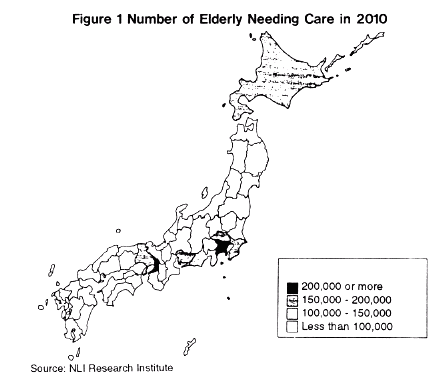
|
2. Trends in Japan's Welfare Policies−Institutional, At-Home, and Integrated Care The relationship between aging and welfare policies in other countries shows that emphasis is first placed on institutional welfare when the proportion of elderly exceeds 7% of the population, and then shifts to at-home welfare as the proportion nears 14%. This shift can be explained as follows: when the proportion of elderly people is relatively low, demand for care is scattered and best dealt with through institutions; but as the population ages, the growing demand for care must be accommodated more locally, while at the same time the right to live at home is increasingly stressed under the concept of normalization. As the proportion of elderly rose in Japan, welfare policies began shifting in emphasis from institutional welfare to at-home welfare in the 1980s. However, due to the rapidity of aging, this shift occurred before institutional welfare had been fully developed. Thus welfare institutions for the elderly have not become outmoded; rather, they need to be developed alongside basic at-home services. Moreover, efforts to reduce Japan's massive fiscal deficits necessitate the efficient use of available resources to expand the quantity of services without compromising quality. This requires that institutional and at-home services be integrated, and that welfare services be provided as efficiently as possible through the effective use of all available welfare resources.
|
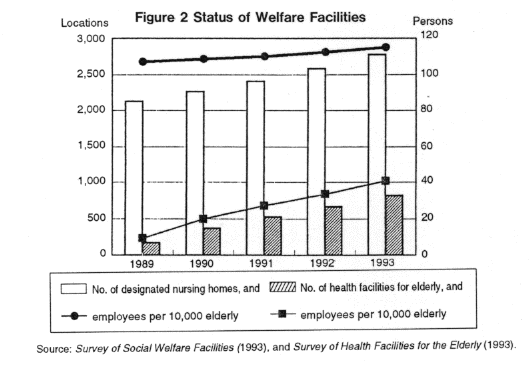
| In addition, if public nursing care insurance under debate today is implemented, it is expected to socialize nursing care, advance at-home care, expand private sector services for the elderly ("silver" services), and introduce market principles into the welfare field. These developments would greatly alter the environment for welfare policy and significantly restructure the social welfare system.
|
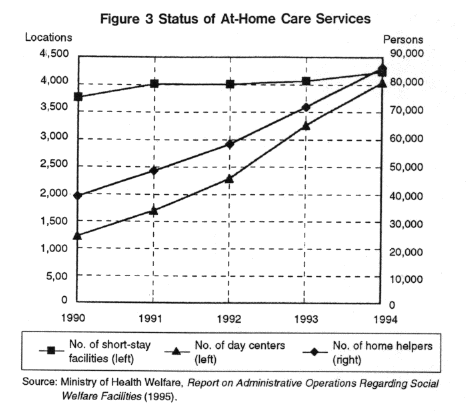
|
3. Welfare Infrastructure to Support Independent Living for Elderly Persons To support elderly persons in living independently, the New Gold Plan (1994) significantly shifted welfare policies for the elderly from institutional welfare to at-home welfare. In the future, along with construction of welfare facilities, the following facilities must be developed to support better universal at-home welfare. First is the construction of diverse housing alternatives for the elderly so that they can live safely and securely; second, establishment of support facilities for at-home nursing care services; third, enhancement of care management to provide integrated care; and fourth, development of a silver services supply network in the private sector. (1) Diverse Housing for the Elderly 1. Housing for the Elderly in Major Metropolitan Areas Due to limitations imposed by high land prices and scarcity of land, housing in metropolitan areas is characterized by low living standards, deteriorating structures, crowding, and collective and high-rise housing. The quality of urban housing for the elderly needs to be improved with barrier-free access and care support services, and the large concentrations of dangerously deteriorated wooden houses must be reduced. Presently, a variety of housing is being supplied to the elderly, including "silver housing," housing with care services, "senior housing," private "senior housing," and fee-charging homes for the elderly. In the future, it will be important to expand care services to meet the needs of elderly people, and to offer a diverse selection of affordable housing alternatives such as lifetime leasing, built for sale housing, and rental housing. 2. Housing Alternatives to Accommodate Changing Family Compositions Since a large proportion of the metropolitan elderly populations consists of single-person and two-person households, housing must be built to ensure that they can live safely and with peace of mind. In addition, as fewer children live with their parents and more elderly people live alone, the burden of care is shifting from the family to the community, making it increasingly important to build housing stock capable of providing at-home care. In addition to constructing housing that is completely barrier-free, there is a need to build collective housing that offers new lifestyles for healthy single elderly people, and group homes to accommodate the growing number of elderly with dementia. Furthermore, community planning needs to incorporate housing projects that intermix generations rather than isolate the elderly, centers that provide at-home welfare services, barrier-free public transportation, and "shop mobility" for elderly persons. (2) Adult Day Care Centers Elderly persons who lead an active life need supportive facilities including sports facilities and continuing education centers. On the other hand, elderly who need at-home care need access to facilities that provide day care and short- stay services. The following three points are important regarding the latter facilities. 1. Cooperation and Integration with Conventional Care Facilities In building service centers to support at-home care in metropolitan areas, cooperation with conventional care facilities will be important. In many cases, day service and short-stay operations are run by designated nursing homes and health facilities for the elderly. These adult day care facilities cannot be efficiently operated without cooperating with conventional care facilities in the use of physical plant and personnel. Recently, welfare facilities for the elderly are increasingly becoming integrated complexes. Some long-term care facilities such as designated nursing homes and health facilities for the elderly have added day centers that provide day care and short-stay services, and local rehabilitation centers. Efficient use of limited welfare resources necessitates the future growth of such comprehensive community welfare centers. 2. Incorporating Day Care Facilities in Urban Planning Due to the self-enclosed nature of conventional adult welfare facilities, few are located within convenient commuting distance. To function as centers for at-home care services in the future, these facilities will need to be conveniently located for elderly persons. As daily use of at-home welfare services becomes more prevalent, the general public will become more aware of the welfare infrastructure. Through education and information dissemination, awareness can then be further enhanced on the importance of networking the welfare infrastructure, prompting urban planners to begin incorporating welfare facilities as well as surrounding streets in redevelopment and subdivision projects. 3. Use of Existing Facilities Considering the stringent outlook for public finances, the development of care facilities and service centers for at-home care can be done more efficiently by adapting existing public facilities. For example, public schools made idle by the decline in children could be converted into welfare facilities for the elderly, while school cafeterias could serve meals to elderly living at home. Converting public facilities in this way will improve the overall efficiency of public services. (3) Enhancement of Care Management to Provide Integrated Care Because individual care needs are diverse, care services need to be comprehensively managed rather than neatly categorized into at-home and institutional care. Care management functions must developed to formulate comprehensive and detailed care plans that are tailored to local conditions. To do this, local at-home care support centers must be built that can perform the function of care management. Presently, 70 percent of the parent facilities of at-home care support centers are designated nursing homes. This fact illustrates the vital importance of the capability to provide care management in cooperation with the delivery of home helper, short-stay, and day services. While cooperation between at-home care support centers and care delivery can enhance the local status of care, it can also cause problems related to the limitations in care delivery and difficulty in monitoring service quality. A local government that has implemented progressive at-home care services has set up liaison committees to provide integrated health, medical, and care services. It points out that while care services can be more personalized, administrative restrictions prevent using welfare resources of the broader area. Thus it is important to unify the management of community information and ensure that elderly persons can access that information. An effective approach is to set up a welfare information center to collect information from both service providers and users in the community. (4) Building a Supply Network for Private Sector "Silver Services" Elderly persons have often been regarded as being unable to look after themselves. However, statistics reveal that among heads of households age 60 and above, the average savings, wealth, and consumption per household are actually rather high. This will be all the more so as the baby boom generation ages. Considering the diversity of lifestyles, active use of outside services, and strong orientation toward financial independence of this generation, the future silver services market is expected to generate substantial consumption and employment. Unlike the past, elderly persons needing care will not only be using nursing facilities, but purchasing a variety of outside services as they enjoy their old age at home.
|
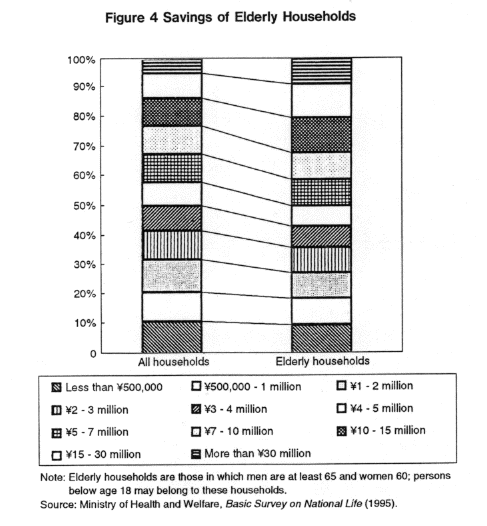
| Private silver service providers and volunteer groups are expected to play a major role in meeting the diverse needs of the elderly. However, the supply system is plagued with problems such as limited service areas, and remains inadequate. As at-home welfare progresses in the future, an intricate network of local facilities will be needed to supply diverse services. The network will bring local residents in contact with silver service providers offering nursing care service management, information, consultation, and equipment exhibits and sales. The development of many such service supply channels and nationwide networks will be important for the private sector to mature and stand alongside public services.
|
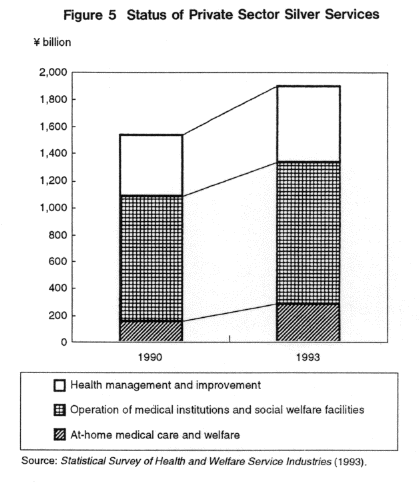
| Conclusion
A major welfare policy issue will be how to build an efficient welfare infrastructure in times of tightening public finances. This makes the effective utilization of welfare resources−both manpower and facilities−all the more important. We must also not forget that the ultimate objective is to build a truly prosperous aging society by providing a variety of welfare services that enable elderly persons to live independently. Last year, the writer visited a welfare equipment center in Australia called the Independent Living Center. Unlike comparable facilities in Japan which display welfare equipment, the emphasis was on aids to facilitate normal daily life in almost all conceivable situations. This difference in approach could not have been clearer-or more important.
|
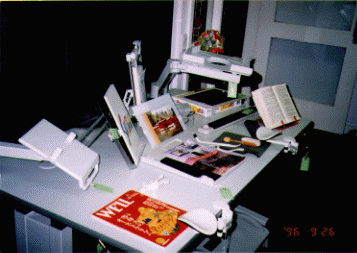
レポート紹介
-
研究領域
-
経済
-
金融・為替
-
資産運用・資産形成
-
年金
-
社会保障制度
-
保険
-
不動産
-
経営・ビジネス
-
暮らし
-
ジェロントロジー(高齢社会総合研究)
-
医療・介護・健康・ヘルスケア
-
政策提言
-
-
注目テーマ・キーワード
-
統計・指標・重要イベント
-
媒体
- アクセスランキング

















